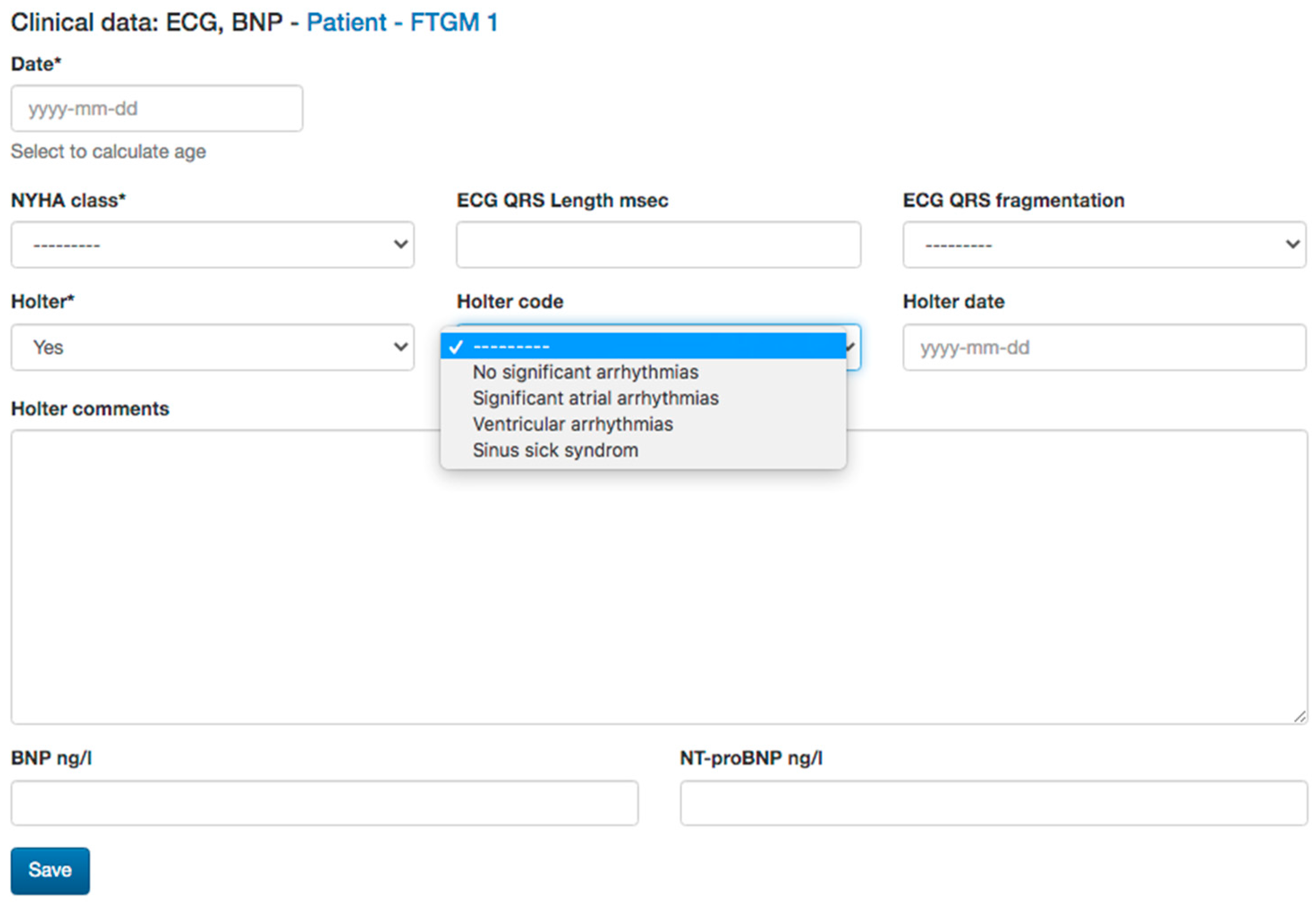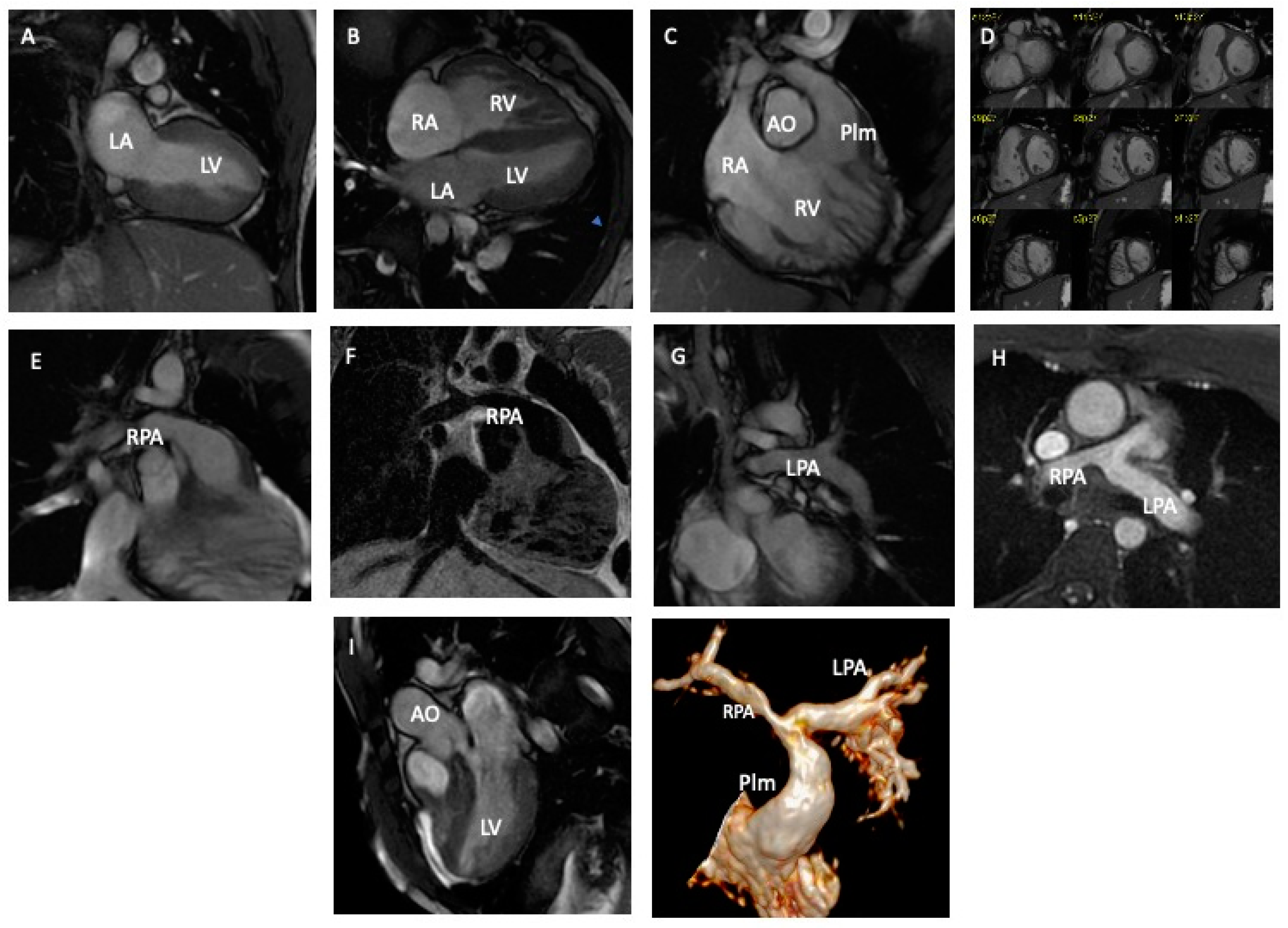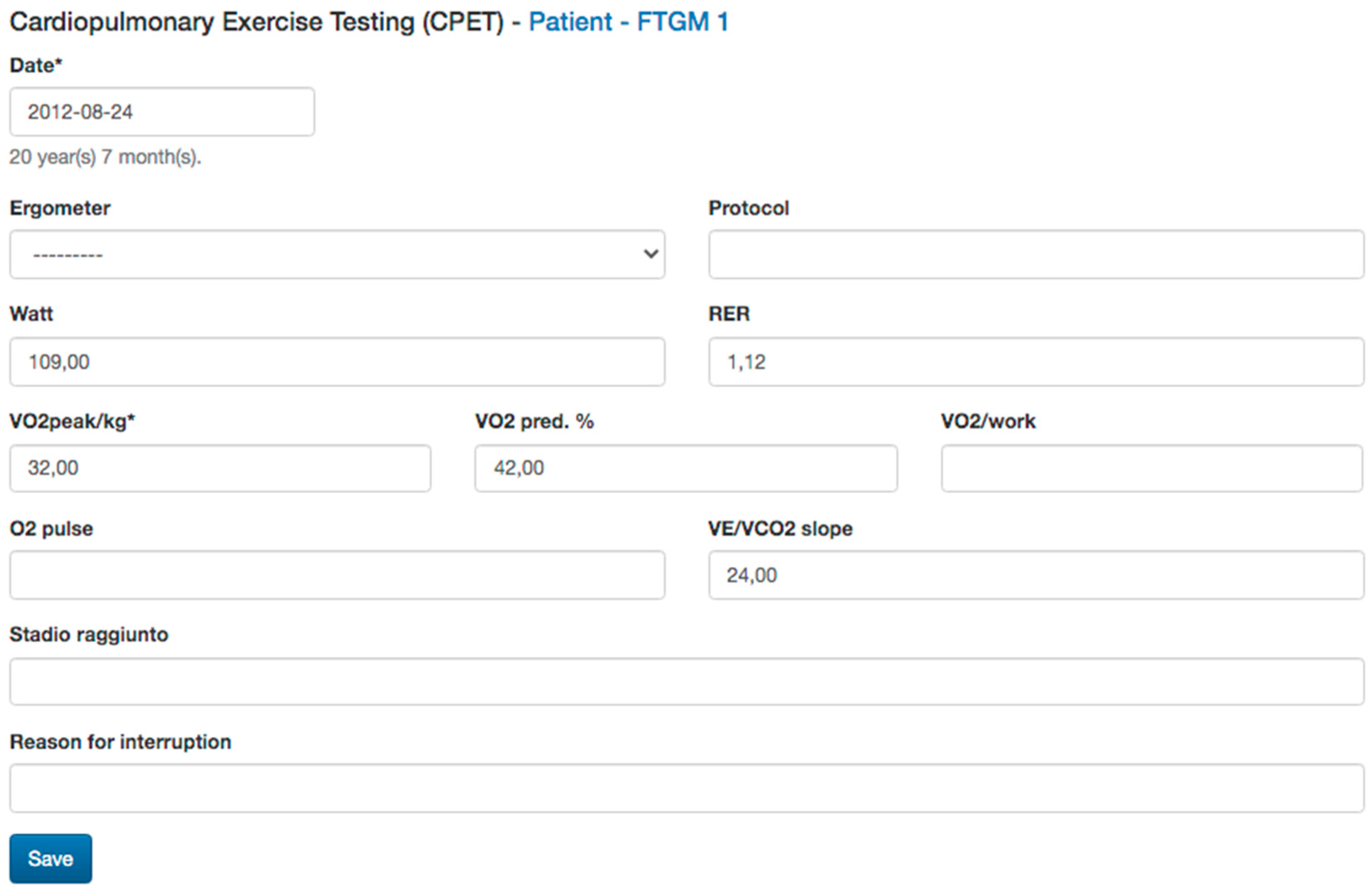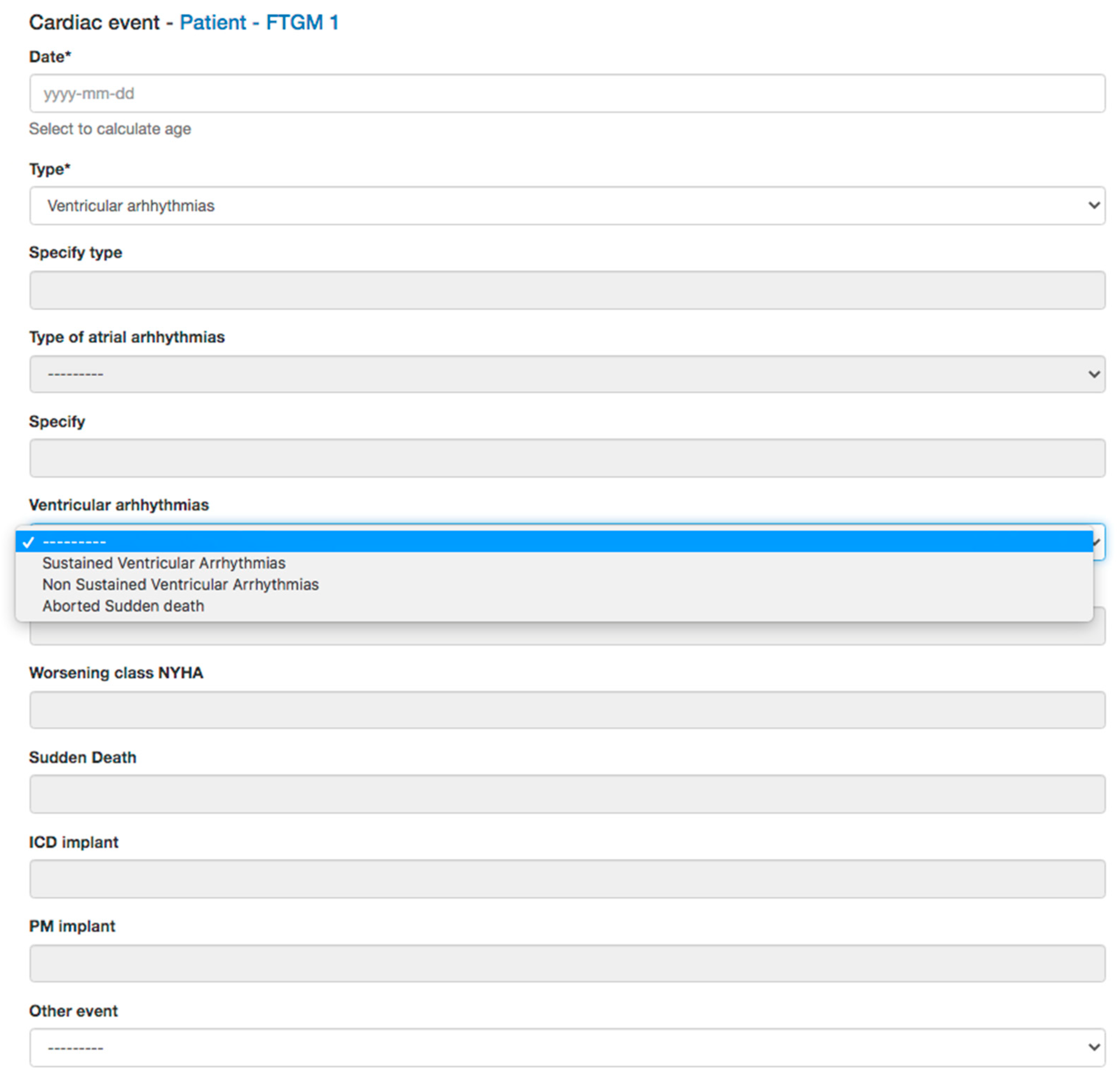Overcoming Underpowering in the Outcome Analysis of Repaired—Tetralogy of Fallot: A Multicenter Database from the CMR/CT Working Group of the Italian Pediatric Cardiology Society (SICPed)
Abstract
:1. Introduction
2. Materials and Methods
2.1. Trial Rationale
2.2. Study Design
2.3. Inclusion Criteria
- Patients with repaired TOF/pulmonary atresia + VSD, double outlet right ventricle (DORV);
- Age > 10 years, as CMR is indicated in younger patients only in exceptional cases.
2.4. Exclusion Criteria
- Different associated complex pathology such as MAPCAs, atrioventricular canal or Ebstein;
- Incomplete CMR study;
- Patients who do not consent to the study;
- Contraindication to CMR.
2.5. Data Collection and Management
2.5.1. The Software Platform for the Implementation of the Clinical Database
2.5.2. Data Collection
- Demographic information form;
- Baseline information about the patient’s health at the time of enrollment;
- Anthropometric data;
- Transthoracic echocardiography (TTE) data: TTE is the first diagnostic tool in this population, allowing the evaluation of many of the anatomic and hemodynamic abnormalities in this population [22]. In particular, the current clinical routine is in tricuspid regurgitation and estimated Doppler systolic right ventricular pressure. The main parameters evaluated by TTE, tricuspid annular peak systolic velocity (TAPSE), and myocardial acceleration during isovolumic contraction have also been investigated in evaluating RV function in this population [2,18]. Therefore, data on bi-ventricular and atrial dimensions and function according are included in the dataset of the study.
- Cardiac Magnetic Resonance (CMR) data: CMR is the gold standard. CMR is considered the reference standard for quantifying RV size, function, and PR in patients with repaired TOF [14,15]. Biventricular volumes and function are predictors of adverse outcomes in repaired TOF and atrial volumes, and function also emerged as prognostic predictors. The LGE score also has been demonstrated to be associated with ventricular arrhythmias, and there is an increasing interest in the prognostic role of T1 mapping in this population. Moreover, CMR allows for the evaluation of the anatomy and flow of the main and pulmonary branches, and it is the unique modality that is able to quantify the pulmonary regurgitation and the pulmonary flow distribution. Therefore, all the anatomic and functional parameters evaluated by CMR comprehensively, as well as the evaluation of the aortic valve for regurgitation and measurement of aortic size, are included in the study dataset (Figure 4).
- Cardiac tomography (CT) data: even if a CT scan is rarely indicated in the routine follow-up, in selected cases with contraindication to CMR or for the evaluation of ferromagnetic device, a CT scan could be useful for the evaluation of coronary arteries, conduit calcification. A CT scan may also be considered as an alternative for ventricular quantification in patients unable to undergo CMR [19]. CT data of bi-ventricular and bi-atrial volumes and bi-ventricular function, as well as diameters of great vessels, could be reported.



2.5.3. Planned Analysis
- Sudden cardiac death;
- ICD implantation;
- Sustained ventricular arrhythmias;
- Non sustained ventricular arrhythmias;
- Atrial flutter, atrial fibrillation;
- Supraventricular tachycardia (SVT) consisted of an abrupt salve of three or more consecutive atrial premature beats at a rate of >100 beats per minute;
- Palpitations associated with syncope or near syncope in patients subsequently found to have inducible sustained SVT;
- Worsening of CMR data in particular dilation of the right ventricle, worsening of bi-ventricular function and heart failure.
3. Preliminary Results
4. Discussion
5. Conclusions
6. Future Development
- Generating a structured report would allow standardization of the CMR report among the participating centers and could help centers with less expertise;
- Integration of the multicenter study Fallot study platform with PACS (picture archiving and communication system) through a specific customized intermediate software would allow for the delivery of anonymized DICOM images into a temporary storage;
- Extending the study to other Italian or Europeans centers.
Author Contributions
Funding
Institutional Review Board Statement
Informed Consent Statement
Data Availability Statement
Acknowledgments
Conflicts of Interest
References
- Hoffman, J. Incidence of congenital heart disease: I. Postnatal incidence. Pediatr. Cardiol. 1995, 16, 103–113. [Google Scholar] [CrossRef] [PubMed]
- Villafañe, J.; Feinstein, J.A.; Jenkins, K.J.; Vincent, R.N.; Walsh, E.P.; Dubin, A.M.; Geva, T.; Towbin, J.A.; Cohen, M.S.; Fraser, C.; et al. Hot topics in tetralogy of Fallot. J. Am. Coll. Cardiol. 2013, 62, 2155–2166. [Google Scholar] [CrossRef] [PubMed]
- Geva, T. Repaired tetralogy of Fallot: The roles of cardiovascular magnetic resonance in evaluating pathophysiology and for pulmonary valve replacement decision support. J. Cardiovasc. Magn. Reson. 2011, 13, 1–24. [Google Scholar] [CrossRef] [PubMed]
- Hosseinpour, A.R.; González-Calle, A.; Adsuar-Gómez, A.; Ho, S.Y. The Predicament of Surgical Correction of Tetralogy of Fallot. Pediatr. Cardiol. 2021, 42, 1252–1257. [Google Scholar] [CrossRef]
- Karali, K.; Makedou, K.; Kallifatidis, A.; Didagelos, M.; Giannakoulas, G.; Davos, C.H.; Karamitsos, T.D.; Ziakas, A.; Karvounis, H.; Hadjimiltiades, S. The Interplay between Myocardial Fibrosis, Strain Imaging and Collagen Biomarkers in Adults with repaired tetralogy of Fallot. Diagnostics 2021, 11, 2101. [Google Scholar] [CrossRef]
- Havers-Borgersen, E.; Butt, J.H.; Smerup, M.; Gislason, G.H.; Torp-Pedersen, C.; Gröning, M.; Schmidt, M.R.; Søndergaard, L.; Køber, L.; Fosbøl, E.L. Incidence of Infective Endocarditis among Patients with Tetralogy of Fallot. J. Am. Heart Assoc. 2021, 10, e022445. [Google Scholar] [CrossRef]
- Geva, T. Indications for pulmonary valve replacement in repaired tetralogy of fallot: The quest continues. Am. Heart Assoc. 2013, 128, 1855–1857. [Google Scholar] [CrossRef]
- Geva, T.; Sandweiss, B.M.; Gauvreau, K.; Lock, J.E.; Powell, A.J. Factors associated with impaired clinical status in long-term survivors of tetralogy of Fallot repair evaluated by magnetic resonance imaging. J. Am. Coll. Cardiol. 2004, 43, 1068–1074. [Google Scholar] [CrossRef]
- Samad, M.D.; Wehner, G.J.; Arbabshirani, M.R.; Jing, L.; Powell, A.J.; Geva, T.; Haggerty, C.M.; Fornwalt, B.K. Predicting deterioration of ventricular function in patients with repaired tetralogy of Fallot using machine learning. Eur. Heart J.-Cardiovasc. Imaging 2018, 19, 730–738. [Google Scholar] [CrossRef]
- Wald, R.M.; Valente, A.M.; Gauvreau, K.; Babu-Narayan, S.V.; Assenza, G.E.; Schreier, J.; Gatzoulis, M.A.; Kilner, P.J.; Koyak, Z.; Mulder, B.; et al. Cardiac magnetic resonance markers of progressive RV dilation and dysfunction after tetralogy of Fallot repair. Heart 2015, 101, 1724–1730. [Google Scholar] [CrossRef]
- Gliklich, R.E.; Dreyer, N.A.; Leavy, M.B. Registries for Evaluating Patient Outcomes: A User’s Guide; Government Printing Office: Washington, DC, USA, 2014.
- Trojano, M. Can databasing optimise patient care? J. Neurol. 2004, 251, v79–v82. [Google Scholar] [CrossRef] [PubMed]
- Ravaglioli, A.; Ait-Ali, L.; Federici, D.; Salvadori, S.; Pllumi, A.; Pak, V.; Marrone, C.; Pizzuto, A.; Bonhoeffer, P.; Festa, P. The impact of native Fallot anatomy on future therapeutic requirements and outcomes at follow-up. Cardiovasc. Ultrasound 2021, 19, 1–9. [Google Scholar] [CrossRef] [PubMed]
- Clemente, E.A.; Casares, Á.P.; Frontera, P.R.; Calvar, J.M.C.; de Toledo, J.S. Finding the Optimal Timing for Repair of Standard Tetralogy of Fallot: Analysis of Cardiac Magnetic Resonance and Echocardiography Parameters Related to Intermediate Term Outcomes in a Pediatric Population. Pediatr. Cardiol. 2021, 42, 1324–1333. [Google Scholar] [CrossRef]
- Egbe, A.C.; Kothapalli, S.; Borlaug, B.A.; Ammash, N.M.; Najam, M.; Bajwa, N.; Tarek, K.; Mathew, J.; Connolly, H.M. Mechanism and risk factors for death in adults with tetralogy of Fallot. Am. J. Cardiol. 2019, 124, 803–807. [Google Scholar] [CrossRef] [PubMed]
- Bokma, J.P.; Winter, M.M.; Vehmeijer, J.T.; Vliegen, H.W.; van Dijk, A.P.; van Melle, J.P.; Meijboom, F.J.; Post, M.C.; Zwinderman, A.H.; Mulder, B.J.; et al. QRS fragmentation is superior to QRS duration in predicting mortality in adults with tetralogy of Fallot. Heart 2017, 103, 666–671. [Google Scholar] [CrossRef] [PubMed]
- Berul, C.I.; Hill, S.L.; Geggel, R.L.; Hijazi, Z.M.; Marx, G.R.; Rhodes, J.; Walsh, K.A.; Eulton, D.R. Electrocardiographic markers of late sudden death risk in postoperative tetralogy of Fallot children. J. Cardiovasc. Electrophysiol. 1997, 8, 1349–1356. [Google Scholar] [CrossRef]
- Valente, A.M.; Cook, S.; Festa, P.; Ko, H.H.; Krishnamurthy, R.; Taylor, A.M.; Warnes, C.A.; Kreutzer, J.; Geva, T. Multimodality imaging guidelines for patients with repaired tetralogy of Fallot: A report from the American Society of Echocardiography: Developed in collaboration with the Society for Cardiovascular Magnetic Resonance and the Society for Pediatric Radiology. J. Am. Soc. Echocardiogr. 2014, 27, 111–141. [Google Scholar]
- Toyono, M.; Harada, K.; Tamura, M.; Yamamoto, F.; Takada, G. Myocardial acceleration during isovolumic contraction as a new index of right ventricular contractile function and its relation to pulmonary regurgitation in patients after repair of tetralogy of Fallot. J. Am. Soc. Echocardiogr. 2004, 17, 332–337. [Google Scholar] [CrossRef]
- Stout, K.K.; Daniels, C.J.; Aboulhosn, J.A.; Bozkurt, B.; Broberg, C.S.; Colman, J.M.; Crumb, S.R.; Dearani, J.A.; Fuller, S.; Gurvitz, M.; et al. 2018 AHA/ACC guideline for the management of adults with congenital heart disease: A report of the American College of Cardiology/American Heart Association Task Force on Clinical Practice Guidelines. J. Am. Coll. Cardiol. 2019, 73, e81–e192. [Google Scholar] [CrossRef]
- Diller, G.P.; Dimopoulos, K.; Okonko, D.; Li, W.; Babu-Narayan, S.V.; Broberg, C.S.; Johansson, B.; Bouzas, B.; Mullen, M.J.; Poole-Wilson, P.A.; et al. Exercise intolerance in adult congenital heart disease: Comparative severity, correlates, and prognostic implication. Circulation 2005, 112, 828–835. [Google Scholar] [CrossRef]
- Baumgartner, H.; De Backer, J.; Babu-Narayan, S.V.; Budts, W.; Chessa, M.; Diller, G.P.; Lung, B.; Kluin, J.; Lang, I.M.; Meijboom, F.; et al. 2020 ESC Guidelines for the management of adult congenital heart disease: The Task Force for the management of adult congenital heart disease of the European Society of Cardiology (ESC). Endorsed by: Association for European Paediatric and Congenital Cardiology (AEPC), International Society for Adult Congenital Heart Disease (ISACHD). Eur. Heart J. 2021, 42, 563–645. [Google Scholar] [PubMed]
- Festa, P.; Ali, L.A.; Prontera, C.; De Marchi, D.; Fontana, M.; Emdin, M.; Passino, C. Amino-terminal fragment of pro-brain natriuretic hormone identifies functional impairment and right ventricular overload in operated tetralogy of Fallot patients. Pediatr. Cardiol. 2007, 28, 339–345. [Google Scholar] [CrossRef] [PubMed]
- Heng, E.L.; Bolger, A.P.; Kempny, A.; Davlouros, P.A.; Davidson, S.; Swan, L.; Uebing, A.; Pennell, D.J.; Gatzoulis, M.A.; Babu-Narayan, S.V. Neurohormonal activation and its relation to outcomes late after repair of tetralogy of Fallot. Heart 2015, 101, 447–454. [Google Scholar] [CrossRef]
- van der Ven, J.P.; van den Bosch, E.; Bogers, A.J.; Helbing, W.A. Current outcomes and treatment of tetralogy of Fallot. F1000Research 2019, 8, 1530. [Google Scholar] [CrossRef] [PubMed]
- Calcagni, G.; Calvieri, C.; Baban, A.; Bianco, F.; Barracano, R.; Caputo, M.; Madrigali, A.; Silva Kikina, S.; Perrone, M.A.; Digilio, M.C.; et al. Syndromic and Non-Syndromic Patients with Repaired Tetralogy of Fallot: Does It Affect the Long-Term Outcome? J. Clin. Med. 2022, 11, 850. [Google Scholar] [CrossRef] [PubMed]
- Secinaro, A.; Ait-Ali, L.; Curione, D.; Clemente, A.; Gaeta, A.; Giovagnoni, A.; Alaimo, A.; Esposito, A.; Tchana, B.; Sandrini, C.; et al. Recommendations for cardiovascular magnetic resonance and computed tomography in congenital heart disease: A consensus paper from the CMR/CCT working group of the Italian Society of Pediatric Cardiology (SICP) and the Italian College of Cardiac Radiology endorsed by the Italian Society of Medical and Interventional Radiology (SIRM) Part I. Radiol. Med. 2022, 127, 788–802. [Google Scholar] [PubMed]



| Patients (Total) | N = 880 |
|---|---|
| Tetralogy of Fallot (n, %) | 797 (90%) |
| DORV Fallot type * (n, %) | 22 (3%) |
| PA + VSD (n, %) | 61 (7%) |
| Age at the last CMR (years) (mean ± SD) | 23.5 ± 12 |
| Previous shunt palliation (n, %) | 288 (33%) |
| Age at primary repair (years) | 1.71 (0.75–4.8) |
| Type of primary RVOT repair | |
| TAP (n, %) | 553 (63%) |
| Infundibular patch/commissurotomy (n, %) | 203 (23%) |
| Valved conduit/homograft (n, %) | 75 (8.5%) |
| Unknown (n, %) | 47 (5.3%) |
| Re-operated patients * (n, %) | 357 (41%) |
| NT-Pro-BNP (n = 305) (Median, Q1, Q3) | 11 (55, 195) |
|---|---|
| VO2/Kg/min (n = 350) (mean ± SD) | 23.5 ± 7.4 |
| QRS duration (ms) (n: 730) (mean ± SD) | 140 ± 28 |
| RVP (mmHg) (n = 391) (mean ± SD) | 46 ± 19 |
| Moderate/severe TR (%) | 12% |
| LASVi (mL/m2) (n = 250) (mean ± SD) | 32.5 ± 17 |
| LVEDVi (mL/m2) (mean ± SD) | 82.8 ± 16 |
| LVEF (%) (mean ± SD) | 58.3 ± 6.7 |
| RASVi (mL/m2) (n = 280) (mean ± SD) | 55 ± 23 |
| RVEDVi (mL/m2) (mean ± SD) | 137 ± 39 |
| RVEF (%) (mean ± SD) | 52 ± 7.7 |
Disclaimer/Publisher’s Note: The statements, opinions and data contained in all publications are solely those of the individual author(s) and contributor(s) and not of MDPI and/or the editor(s). MDPI and/or the editor(s) disclaim responsibility for any injury to people or property resulting from any ideas, methods, instructions or products referred to in the content. |
© 2023 by the authors. Licensee MDPI, Basel, Switzerland. This article is an open access article distributed under the terms and conditions of the Creative Commons Attribution (CC BY) license (https://creativecommons.org/licenses/by/4.0/).
Share and Cite
Ait-Ali, L.; Leonardi, B.; Alaimo, A.; Baccano, G.; Bennati, E.; Bucciarelli, V.; Clemente, A.; Favilli, S.; Ferroni, F.; Inserra, M.C.; et al. Overcoming Underpowering in the Outcome Analysis of Repaired—Tetralogy of Fallot: A Multicenter Database from the CMR/CT Working Group of the Italian Pediatric Cardiology Society (SICPed). Diagnostics 2023, 13, 3255. https://doi.org/10.3390/diagnostics13203255
Ait-Ali L, Leonardi B, Alaimo A, Baccano G, Bennati E, Bucciarelli V, Clemente A, Favilli S, Ferroni F, Inserra MC, et al. Overcoming Underpowering in the Outcome Analysis of Repaired—Tetralogy of Fallot: A Multicenter Database from the CMR/CT Working Group of the Italian Pediatric Cardiology Society (SICPed). Diagnostics. 2023; 13(20):3255. https://doi.org/10.3390/diagnostics13203255
Chicago/Turabian StyleAit-Ali, Lamia, Benedetta Leonardi, Annalisa Alaimo, Giovanna Baccano, Elena Bennati, Valentina Bucciarelli, Alberto Clemente, Silvia Favilli, Francesca Ferroni, Maria Cristina Inserra, and et al. 2023. "Overcoming Underpowering in the Outcome Analysis of Repaired—Tetralogy of Fallot: A Multicenter Database from the CMR/CT Working Group of the Italian Pediatric Cardiology Society (SICPed)" Diagnostics 13, no. 20: 3255. https://doi.org/10.3390/diagnostics13203255
APA StyleAit-Ali, L., Leonardi, B., Alaimo, A., Baccano, G., Bennati, E., Bucciarelli, V., Clemente, A., Favilli, S., Ferroni, F., Inserra, M. C., Lovato, L., Maiorano, A., Marcora, S. A., Marrone, C., Martini, N., Mirizzi, G., Pasqualin, G., Peritore, G., Puppini, G., ... Festa, P., on behalf of the CMR/CT WG of Italian Pediatric Cardiology Society. (2023). Overcoming Underpowering in the Outcome Analysis of Repaired—Tetralogy of Fallot: A Multicenter Database from the CMR/CT Working Group of the Italian Pediatric Cardiology Society (SICPed). Diagnostics, 13(20), 3255. https://doi.org/10.3390/diagnostics13203255







